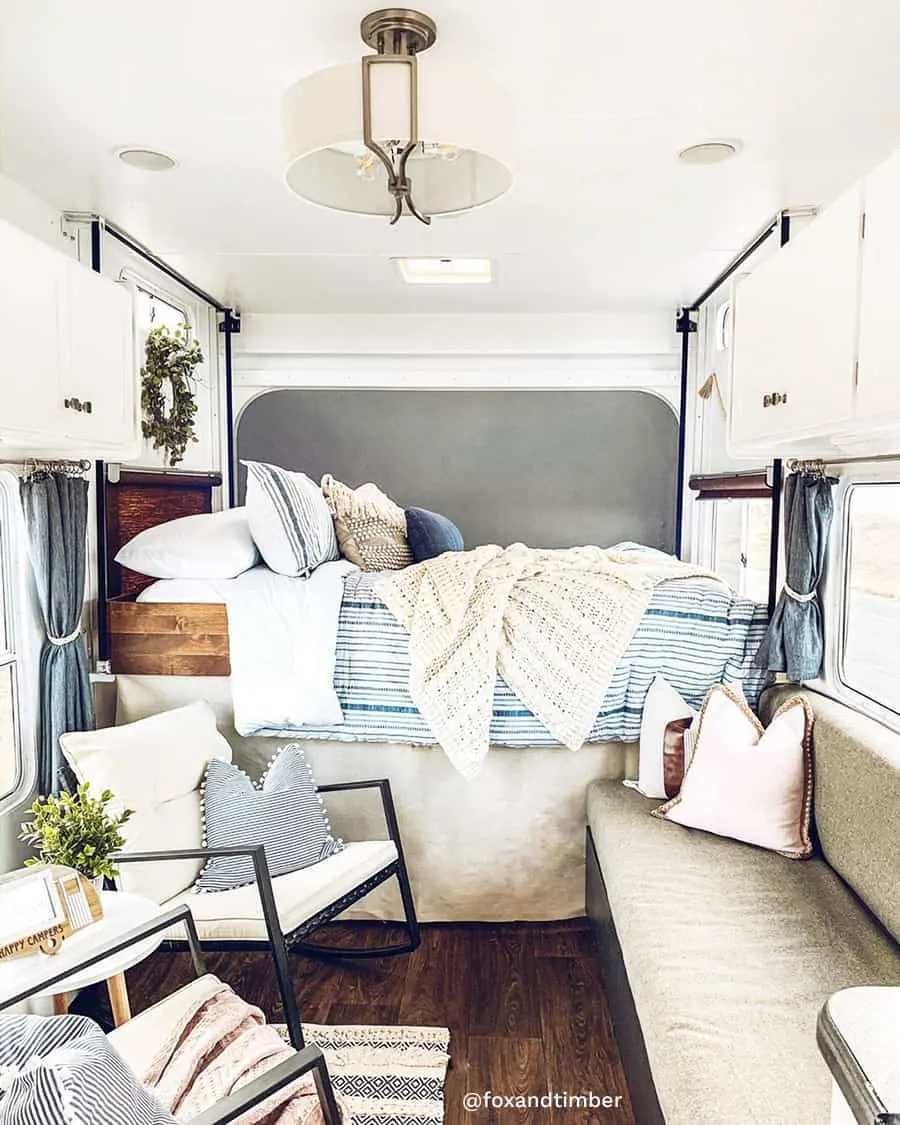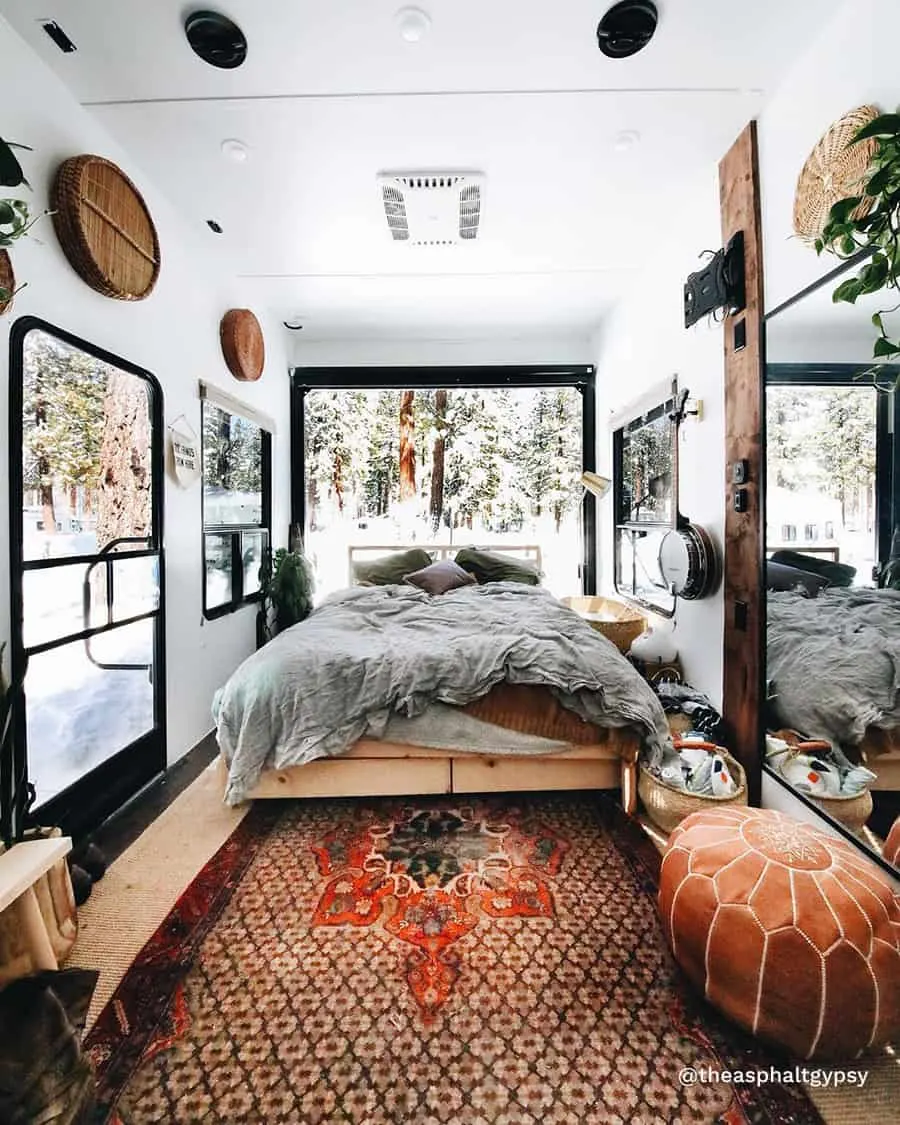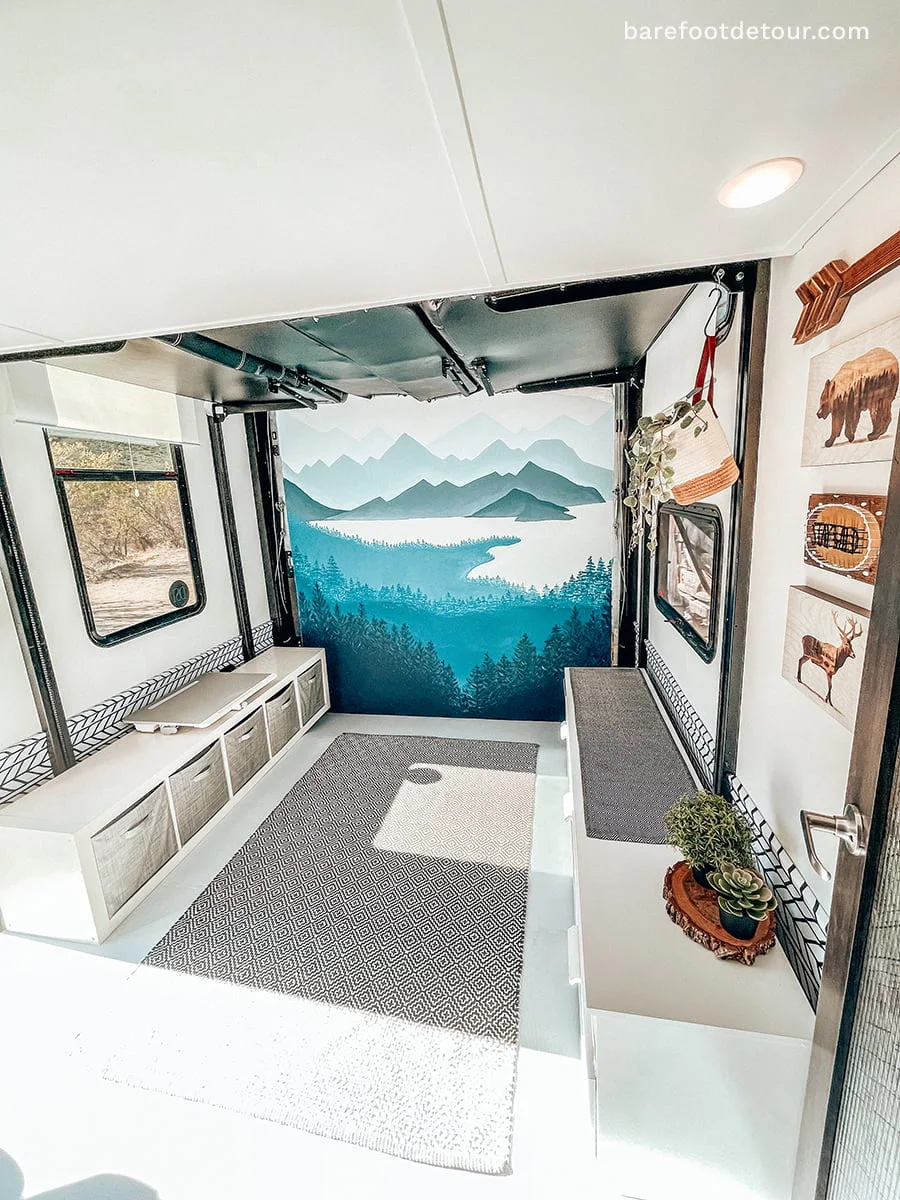RV Toy haulers are the James Bond of the RV world. It’s a mobile home, 5th wheel, or travel trailer that hides a little something extra inside, a lot like one of 007’s handy gadgets. Best of all, it solves more than a few problems #vanlife enthusiasts might experience in their pursuit of mobility and activities.

Want to know more about RV toy haulers and if you should get one? Carry on reading for all the interesting facts, stats, and info you’ll ever need to have about these genius vehicles.
- What is a Toy hauler?
- RV Toy Hauler size and weight capacity makes all the difference
- How do Toy Haulers work as an RV?
- Are Toy Haulers more expensive and heavier compared to other RVs?
- Is the smell of gas or oil an issue inside Toy Haulers?
- RV Toy Hauler costs, styles, and footprints
- Who Should Buy a Toy Hauler?
- RV Toy Hauler Prices
- Footprint: What MPG Can RV Toy Haulers Reach?
- Conclusion

What is a Toy hauler?
What? Another RV Category!
Yes, I know. There are quite a few RV categories on the market, and it can all get a little confusing. That’s why it’s important to understand the basic differences and advantages of each type before venturing out to look at models.
Class A, B, B+, and C camper vans cater to the storage and space requirements of many different travelers. Then there are mobile homes, travel trailers (such as fifth wheels), cute little teardrops, and everything in between. So where do RV toy haulers fit in?
RV designers are always looking for ways to up their game, and by creating toy haulers, they were able to do that and offer RV buyers an innovative concept at the same time. The name itself is confusing because it makes folks think to themselves, “My kids don’t have so many toys that they need their own trailer!”
We’re actually talking about equipment-type toys here:
- ATVs
- MotoX/off-road/dirt bikes
- Golf carts
- Adventure gear
- Jet skis
- Sports cars
- Wagons
Think about all the fun sports and outdoor adventure vehicles you have stored in the garage, and then imagine owning a motorhome or travel trailer that can transport them everywhere for you. That’s a toy hauler.


RV Toy Hauler size and weight capacity makes all the difference
As can be seen from the above image, toy haulers come in a wide range of sizes and features. They range from zippy travel trailers with a ramp at the back allowing you to easily remove a motorcycle, to a monster-size double-story motorhome with space for a full-size car. That’s the beauty about toy haulers, you’re sure to find the perfect one for you.
This also means you have to give serious thought to which toys you want to transport, and what kind of space and luxury level you want on the actual living side, before buying the right toy hauler for you and your family.
A narrow, shorter length, budget-priced travel trailer or motorhome with toy hauler capabilities will offer you basic living and toy space, but be much easier to drive, park, and afford. Motorhome-style toy haulers also have the additional benefit of not requiring a dedicated towing vehicle. They will have a ramp at the back and a space on the floor next to the ramp where your toy will stand tethered during transport. That’s about it.
Toy hauler sizes and weights go all the way up the scale until you reach the huge motorhomes or articulated trailer homes, such as fifth wheels. Besides creating an environment for the traveler that enables them to live in five-star luxury, they will have a designated garage integrated into the toy hauler where sports cars, jet skis, and golf carts can be stored and transported. The downside, of course, is that they are expensive to run, difficult to park, and the bigger ones might even require a special driver’s license.

How do Toy Haulers work as an RV?
Toy haulers definitely put the “recreation” side of things into a recreational vehicle! They can be more than just an RV with a garage space. They can be fifth wheels, travel trailers, or motorhomes, and feature a large ramp-door in the rear for easy access, or a slot between the axles or underneath the living area where toys can be stored and transported.
They work by allowing you to load up your toy/s into the “garage” space via the ramp door. Then all you have to do is secure the load correctly (the equipment needed to do this safely is included with the toy hauler), and travel on to your chosen destination.
Whether you decide a toy hauler is an ideal way to augment your full-time RV life or a nice way to carry your favorite toys with you over the weekends, everyone can agree that the convenience factor of toy hauler ownership is more than obvious.
Many ramp doors are designed to serve a dual purpose: they can remain folded out to become a porch or be left down so you can drive your auxiliary vehicle back in when you’ve finished playing with it. If you don’t feel comfortable having one side of your toy hauler open when there’s bad weather or privacy issues, the ramp door can be folded up again once the toys have been taken out.

Are Toy Haulers more expensive and heavier compared to other RVs?
Because toy haulers are manufactured to be able to handle the additional weight of the actual toys, they can be heavier than your average non-toy hauler trailer or camper van. While nothing is stopping you from securing a bicycle or scooter inside your van/travel trailer without it being a purpose-built toy hauler, it does make it more convenient to have a specially designated space for your toys’ transport.
Because of its construction and features, a toy hauler will cost more and be heavier than an RV that doesn’t have a special space for toys.
- The axles have a higher weight-rating
- The “garage” floor is constructed out of heavy duty materials
- Ramp doors are specially reinforced to handle toys’ weight when entering and exiting
- Additional heavy duty hardware – strap-ins systems; tie-down bars; belts − attached at crucial points to help secure the load for transport
All the above-mentioned features come with additional costs and weights.
Is the smell of gas or oil an issue inside Toy Haulers?
Anyone who’s spent time in a poorly maintained garage will understand how bad the fumes of motorized toys can get within a confined space. Is smell an issue when it comes to toy haulers? Well, it depends on the type of toy hauler, and we mean that it all comes down to the features and price tag.
You’ll be pleased to know that most toy haulers come with a solid wall that acts to separate the living area of the unit from the garage area. The wall contains a door that allows access from the living quarters to the garage. Walls that divide up the two different areas are called vapor walls.
Vapor walls are specifically designed to reduce the possibility of toy fumes entering the area where people sleep and relax. This will be good news for any full-time RV campers out there who also use their van or trailer as a remote workplace.
Vapor walls significantly reduce fume smells emanating from spills and fuel cans in the garage area. As an extra precaution, the flooring where toys are transported and stored is sometimes constructed out of petroleum-resistant materials as well. Because this surface doesn’t absorb fuels spills, it’s easier to clean and won’t hold on to odors.
Another feature found in toy haulers, to help reduce fuel fumes, is vents in the sidewalls. They are placed at the top and bottom of the toy hauler’s garage section and help filter out fumes while the vehicle is stationary, and also when it’s on the road.
As you can see by the wide selection of toy haulers, not every model is going to feature the latest cutting-edge technology in fuel vapor extraction. The smaller models won’t include a vapor wall or floor constructed out of special fuel spill-resistant materials, but will usually have filters at the back to help with venting. This shouldn’t be a problem once you reach your destination – you’ll be outside with the toys and the ramp door will be open.
For anyone who struggles in temperature extremes, the garage section of a toy hauler does not offer AC or heating – you’ll have to be on the living area side for that.

RV Toy Hauler costs, styles, and footprints
As previously mentioned, toy haulers are available in a huge array of styles and sizes. You have to decide which features your family needs most while factoring in what kind of budget you feel comfortable with (running costs and price) and what footprint you want to leave (gas consumption will be linked to how often you move around, the distance you travel, and how frequently you use the toy hauler).
You also need to think about which toys your hauler will be large enough to bring. Do you need a garage for a sports car or does the family have two top-of-the-range ATVs that you need to transport? Your adventure gear and auxiliary vehicles are what will dictate which toy hauler you should buy.
Toy haulers are permitted a higher-than-average gross weight load limit. This is not only to factor in the additional weight of the toys, but the strap-in systems, tie-down bars, vapor walls, fuel spill-resistant floors, and back ramps as well! The safety of the passengers is guaranteed when your RV has the right equipment to stop your gear from slipping around while the rig’s in motion.
Most mid-range toy haulers are towable RVs. They require an adequately powered towing vehicle to haul them. Motorhome toy haulers are on the market as both Class A and Class C type RVs, but they are only for RV enthusiasts that want the whole “all-in-one” experience.
A quick reminder for anyone who has forgotten the size and shape of Class A and Class C RVs: Both of these RV models lend themselves very well to being adapted into toy haulers.
As far as trailers go, toy haulers can be fifth wheels or gooseneck/bumper pull travel trailers, but you’ll struggle to fit a bicycle into a teardrop or pop-up trailer unless the bike’s collapsible/foldable.
Not to get into a “motorhome vs. travel trailer” debate here, but two things must be kept in mind.
1. If you buy a trailer-type toy hauler, it will be possible to uncouple your tow vehicle from the trailer at the campgrounds and use the tow vehicle independently of the trailer.
2. If you buy a motorhome-type toy hauler, it will cost significantly more due to the high-powered engine needed to haul the living area, garage space, and toys being included in the price.
Toy Hauler
- Price: From $20,000 <
- Weight (unloaded): From 3,600 to 35,000lbs
- Height: 10 to 13 feet
- Width: 8 to 10 feet
- Length: From 35 to 45 feet
Fifth Wheel
- Price: From $20,000 <
- Weight (unloaded): From 12,000 to 15,000lbs
- Height: 9 to 12 feet
- Width: 8 to 10 feet
- Length: From 30 to 45 feet
Travel Trailer
- Price: From $20,000 <
- Weight (unloaded): From 4,500lbs
- Height: 8 to 10 feet
- Width: 7 feet >
- Length: From 8 to 40 feet

Who Should Buy a Toy Hauler?
Toy haulers are great for many people’s lifestyles, but are best suited for the following RV enthusiasts:
- Outdoor activities and recreation fans
- Motorcycle and motorsports devotees
- Tailgaters
- Pet owners (the back ramp/side patio areas allow pets their own space outside, while the side rails help contain them.
When you look at toy haulers, fifth wheels, and travel trailers’ dimensions side by side, you can see toy haulers come out tops for size, weight, and price. This adds up to a whole lot more space, as they offer maximum cargo and living space out of all the RVs on the market.
Measure the height, length, and width of the toys you want to transport before buying a hauler to ensure the floorplan and garage are big enough for them. Also, consider the gross weight of your toys altogether and make sure the payload weight of the hauler is not exceeded.

RV Toy Hauler Prices
On average, the price of a new toy hauler can set you back about $90,000, although prices span anywhere from $20,000 to $250,000, depending on the level of luxury, make, and size.
These features will play the biggest part in how much a toy hauler costs:
- Size
- Weight
- Design
- Brand name
- Floor plan
- Amenities
- Materials
- How many people it sleeps
Of course, toy haulers can be bought cheaper second-hand, similar to any other vehicle that depreciates in value once it leaves the shop floor. You can find them for sale for around 25% less than the price paid at dealers. The pros and cons of used RVs are many, but if you’re on a budget then it could be the best way forward for you.
Used toy hauler tips:
- 1. You’ll be able to pick up a bargain more easily after the summer months and just before school term begins.
- 2. Check the condition of the vehicle and factor that into the asking price.
- 3. You can ask the seller questions such as what made them buy their hauler, why they want to sell it, and what they enjoyed about it the most.
- 4. Request maintenance and service records.
- 5. Check tires, battery, water level, and overall condition.
Buy New Toy Hauler
- PROS: It will be in perfect condition; comes with limited warranty; chance of financing; ability to shop around for best deal.
- CONS: Depreciation; high price.
Buy Used Toy Hauler
- PROS: Considerably cheaper price; might have upgrades from owner.
- CONS: Hidden problems; full maintenance check required before driving; bigger price drop when you want to sell.
Footprint: What MPG Can RV Toy Haulers Reach?
The amount of fuel your toy hauler uses depends on the following:
- What type of tow vehicle you have or if you are driving a toy hauler/motorhome
- The speed you drive
- What terrain you encounter en route
- Type of fuel
- Headwinds and weather
- When last was your RV serviced
- What are the towing weights of both tow vehicle and toy hauler?
- Diesel or gasoline – diesel RVs cost more to buy but save on fuel price.
Because of the huge variation in toy hauler lengths, weights, sizes, and towing vehicles, it can make an MPG (miles per gallon) estimate a real challenge. The best average would be somewhere around the 9 to 12 MPG range. So, for a 20,000-mile road trip, you could expect to spend $5,000 to $10,000 on gas and oil. The average family using their RV for weekends drives far less than 5,000 miles every year, and it’s still more affordable than paying for hotels and air flights.
We selected a Toy Hauler as our full-time RV house on wheels because we wanted to option to be able to take our ATV with us when we move, but also because I loved how we would have a long AND two Queen beds in the garage.

I painted the door of our toy hauler, and I am super excited with how the pace looks, considering it’s a garage. BUT since for now, it’s the boy’s room, I wanted them to have the most amount of floor space possible for Legos.
Conclusion
The best thing about nomad life and RV adventures is its huge appeal to such a wide range of tastes, likes, and pursuits. A toy hauler is a prime example of how wonderfully versatile RVs can be. Essentially, a toy hauler is a travel trailer or fifth wheel with a garage. If you have plans to travel around the country with your favorite jet ski or ATV, a toy hauler rig would be ideal.

